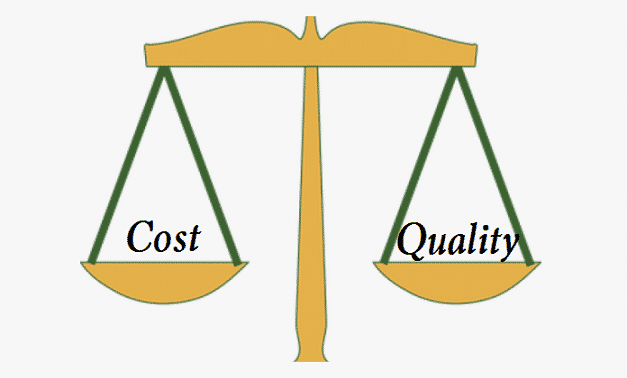People engaged in quality management often have the responsibility to raise the value of quality and reduce the cost of quality at the same time, however, the increase of quality requires the investment of cost. What should we do to solve this problem?

What is the Cost of Quality? – CoQ Components
The Cost of Quality (CoQ) refers to all expenses incurred to prevent errors. The basic composition of cost of quality is usually divided into three or four parts:
- Prevention cost: such as quality engineering, quality management system, training, etc.
- Appraisal cost: or identification cost, such as quality inspection, test, etc.
- Failure cost: or failure cost. Failure cost can be divided into internal cost and external cost, such as repair, rework, scrap, etc.
What Should You Do with Cost of Quality?
The main concern of this article is whether the rise in quality level and the decline in cost of quality can be considered?
First, let’s look at the relationship between the cost of quality and quality level.
- Prevention cost: as the name suggests, it is the cost of preventing problems. The more prevention work is done, the higher the quality level is, and the failure cost will decrease accordingly.
- Appraisal cost: it has a similar curve to the prevention cost. The more identification work is done, the lower the failure cost will be.
- Failure cost: the lower the quality level, the higher the failure cost.
In the product life cycle, the initial quality level is often the lowest. At this time, the failure cost is the highest and the prevention and identification cost is relatively low. Then, with the increase in prevention costs and identification costs, the quality level continues to rise and the failure cost continues to decline.
How does the cost of quality change during production?
- In the first stage, from the beginning of production to the gradual maturity of the product, the cost of prevention and identification continues to increase, the cost of failure decreases rapidly, and the total cost of quality continues to decrease until the lowest point of the curve, and the quality level reaches a high level. At this time, the cost of quality decreases, and the quality level rises, which perfectly takes into account the dual indicators. However, there is no end to the continuous pursuit of quality level. Let’s continue to look at what will happen next.
- At the starting point of the second stage, the total cost of quality has reached the lowest value, and the quality level has been significantly improved. Taking the yield rate of products as an example, the quality level may have increased from 80% to 95%. At this time, contradictions begin to appear. 95% yield is the lowest point of cost of quality. From the perspective of the cost of quality economy, the status quo should be maintained at this time, so that the cost of quality can be controlled at the lowest level. From the perspective of quality level, 95% yield still can not meet the requirements of customers or market competition, and the quality level must continue to improve.
The paradox has also begun to appear: either continue to invest in the cost of prevention and identification to improve the quality level or give up the indicators of continuous improvement of the quality level to ensure the low level of the total cost of quality. What we should do?
The answer is to continue to invest in the cost of quality and improve the quality level. The total cost of quality will finally reach a critical point and then decline rapidly. All this wonderful thing happens because of it: implicit cost of quality. The cost of quality mentioned in the previous discussion is the explicit cost of quality, which can be seen directly from the financial statements, but we often ignore the invisible part of the implicit cost of quality.
The implicit cost of quality refers to the opportunity cost caused by the poor quality of products or services provided. Because of the low level of product quality, enterprises may not get a large market share, may not get subsequent orders from customers, and may not be able to develop new customers. These losses caused by the low level of quality are often very huge, but invisible.
Another huge benefit of paying attention to the hidden cost of quality is that it will encourage enterprises to continuously improve the quality level to reduce the hidden cost of quality, and then reduce the total cost of quality (explicit + implicit). Finally, the hidden cost even becomes negative. At that time, the excellent quality level will not produce the hidden cost of quality but will bring strong market competitiveness and obtain more market share because of the excellent quality, So far, quality is no longer the cost, but the core competitive advantage of the enterprise.